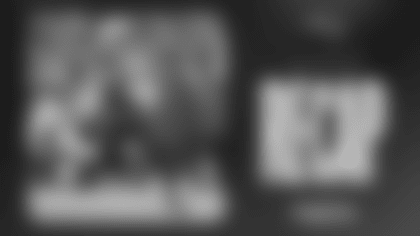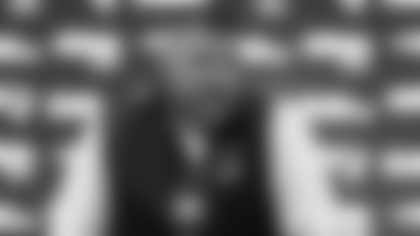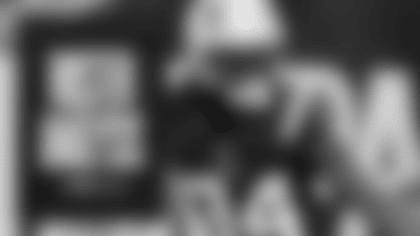Everyone had a take on the state of the Patriots offense during the bye week.
Is it the coaching and scheme? Receivers? Offensive line? Quarterback? Let's hand out slices of the blame pie! Had enough of that yet? With the Patriots finally returning to the field for a crucial divisional rematch with the Jets at Gillette Stadium, there's a clear message from the players actually participating in Sunday's game.
"That's the biggest thing: cut down on bad football, negative plays," Patriots captain David Andrews said this week. "It's hard to say you want to do something when you're playing behind the sticks, hurting yourself. I've never called a game before, but it's hard to call a game when it's second-and-5, and the next thing you know, it's third-and-12. That's the big thing: We've got to stop hurting ourselves."
The stats behind Andrews's point don't paint a pretty picture of New England's early-down offense. Efficiency on third down and in the red zone are consistently referenced, but keeping the offense on schedule makes it easier to convert in those situations.
| Stat | 2022 Season (rank) | 2021 Season (rank) |
|---|---|---|
| Early-Down EPA/Play | -0.07 (30th) | +0.05 (11th) |
| Early-Down Avg. Yards/Play | 4.8 (T-28th) | 5.4 (T-9th) |
| Avg. Third Down Distance to Sticks | 7.2 (T-26th) | 6.4 (5th) |
| Third Down Conversion Rate | 39.1 (21st) | 43.9 (7th) |
On first and second down this season, the Patriots are 30th in expected points added and are tied for 28th in yards per play. As a result, the Pats have an average third-down distance of 7.2 yards, tied for the seventh-highest in the NFL. New England has also been called for 17 offensive holding penalties and 12 false starts, ranking in the league's bottom half in both penalties.
Cutting down on pre-snap penalties and holding calls on early-down runs is a must. But the play-calling also needs to improve for the first and second down offense to wake up down the stretch.
For example, the Patriots tendency to run the ball on first down out of their two tight-end "nub" formations is leading to very few productive plays. Above, the Colts matched the formation with a single-high safety, and despite being short on numbers, they ran into the loaded box for no gain.
In the past, the Pats have used defenses loading the box with a single-high safety against opponents by throwing out of these formations. Whether it's a called pass play or checking into a pass, that's when New England goes to work on play-action.
Although we've seen glimpses of that play-action success, it hasn't come with second-year quarterback Mac Jones under center. Jones and the pass offense are struggling from under center this season, ranking 33rd out of 39 qualified quarterbacks in passing yards per attempt (5.9). Keeping the offense on schedule could mean returning to their 2021 play-action concepts.
This season, New England is dialing up deeper passing schemes off play-action with Jones taking deeper drops. Rather than pulling the second level towards the line of scrimmage with a run action to hit open receivers behind the linebackers, the Pats are trying to stress single-high coverage vertically to take shots downfield.
With the struggles of the offensive line, receivers who are mostly short and intermediate threats, and a quarterback better suited to get the ball out quickly, changing back to the second-level routes off play-action could jumpstart things offensively.
"I know we wanted to be better at stretching the field vertically. That was a real big thing we talked about because a lot of teams were just stacking the box. As a receiver group, we wanted to be a group that defenses had to respect, so they couldn't just drop a safety down and play man-to-man," wide receiver Jakobi Meyers told Patriots.com. "It's different. It's changed. I'm excited about it."
Quarterback Mac Jones added on Wednesday, "I wouldn't make comparisons [to last year]. Just two different offenses and different coaches, different players."
Along with taking a different approach to things from under center, the Patriots have begun to build a run-pass option package that needs to be expanded upon as we move forward.
In the two games before the bye, New England ran 21 RPOs where they paired inside runs (inside zone) or pin-pull sweeps with outside screens. In their win over the Jets back in Week 8, the Pats ran 14 run-pass options and were successful on a handful in the second half.
Although the RPO screens are a good first step, to truly become a dangerous RPO offense, the Pats need to begin running more downfield routes off those run actions (slants, seams, etc.).
For instance, the Packers set up their game-winning field goal in overtime by running a "bluff" slant to wide receiver Allen Lazard that gained 36 yards. Lazard fakes like he's going to block on a screen but then releases upfield on the slant, and Aaron Rodgers hits him in stride. Having Lazard run a slant off the run action sets up a better opportunity for yards after the catch than a screen, and the Packers generate an explosive play. On seven RPO pass attempts in the two games before the bye, Jones averaged just 1.6 yards per attempt because the play designs aren't hitting further downfield.
The Patriots have potential solutions to get their first and second-down offense rolling, but this offense needs to get ahead of the sticks more often to avoid long-yardage situations. Most offenses struggle when they fall behind the chains, and the Pats are no exception.









































